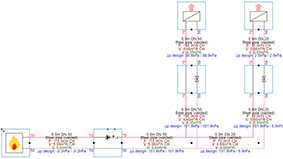Why Valve Authority Often Gets Overlooked
Control valves are typically sized based on flow requirements or percentage opening, but a critical dimension is how much of the total pressure drop the valve actually controls. If the drop across the valve is too small compared to the entire circuit, the valve may become overly sensitive — even slight movements cause large changes in flow. This is the essence of valve authority in a hydronic loop.
In a system where branches close, loads vary and valves modulate, the effective resistance of the circuit changes. When authority is insufficient, the valve’s position becomes unstable, leading to oscillation, inconsistent flow rates and unpredictable temperatures.
How Circuit Layout and Hydraulic Balance Affect Authority
The distribution of pressure loss between pipework, fittings, valves and heat-emission units defines the environment in which a valve operates. When one path has significantly lower resistance than others, flow will preferentially travel that route unless balancing is in place. The role of balance valves is to ensure branches are hydraulically similar, thereby stabilising flow distribution and improving valve performance.
A well-designed hydraulic network also accounts for how pump performance shifts with circuit resistance. A pump operating near its design point may behave very differently when loads drop or multiple valves close — the entire network’s behaviour changes.
The Interaction Between Pump Curves, Control Strategies and Authority
Rather than viewing the valve in isolation, it must be seen in relation to the pump and the controls. A pump runs along its pump curve and a change in system resistance alters its head-flow point. This, in turn, modifies the pressure drop available across a valve and can reduce its authority unexpectedly.
If a control strategy keeps differential pressure too high, or uses an inappropriate mode for the system, valves may operate in a range where small changes trigger large variations in flow. In contrast, matching the pump control mode to the network hydraulics enables valves to stay within their stable authority region and behave predictably.
Identifying and Preventing Stability Problems in Practice
Indicators of low valve authority include:
- control valves cycling or hunting rather than settling
- open-ended circuits receiving too much flow while distant circuits starve
- rapid fluctuations in supply or return temperatures
- higher pump energy use despite lower load conditions
Preventative steps include:
- sizing valves and circuits so that the valve remains a meaningful portion of the total pressure drop
- ensuring parallel branches are hydraulically similar and balanced
- controlling pump head in a way that aligns with valve operation
- verifying part‐load behaviour, not just design point calculations
When authority is managed correctly, valves operate smoothly, flow stabilises and overall system efficiency improves.
FAQ: Valve Authority & Stable Hydronic Operation




